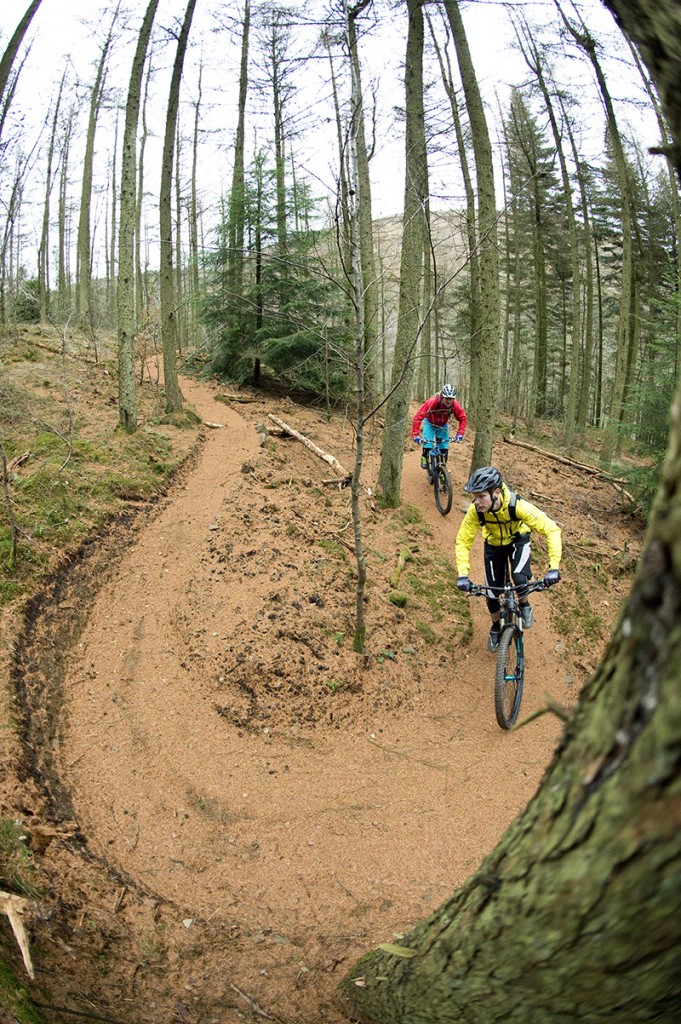XC capabilities paired with progressive geometry that makes it feel like a short-travel enduro bike. There isn’t much out there as competent as this for the price
Whyte T129 longtermer test
After a year of testing the Whyte T129 the final review is in. For five months it’s carried us on weekend fun rides, photoshoots and features across the UK, covering hundreds of miles.
Half way through the test we still had a lot of figuring out to do though, on this British-built 120mm trail bike. Yes we decided long ago that it’s a brilliant bike, fun to ride and good value. But there’s noticeable feeling of trail buzz coming through your hands on really rough descents. Is it the fork? The wheels? The bar and stem? The frame even? This is a diary of the Whyte’s story so far…
Words: Jamie Darlow Pics: Roo Fowler
March 2014
My front wheel recently developed an interesting little shimmy. Instead of running true and wobble-free, it was behaving more like a hula-hoop, twirling drunkenly around its once-perfect hub to the point where its vagaries were really starting to unsettle me. Steering precision disappeared completely and it was slow too, to the point where tipping into a corner took six weeks’ notice and a letter to the council.
On top of that, the hub is now graunchy as hell (probably because of riding it with so much play in the bearings) and the strange oscillation in the wheel slowly opened the Maxle over the course of a ride. It’s been a focus of many a mid-ride chat to wonder precisely which hill I’ll plummet off the side of as the wheel flies free. It’s not going to happen of course — in reality the Maxle is miles away from fully detaching, but nothing spurs chatter like the impending doom of a friend. I reckon the seals simply gave up the ghost during this very wet winter and the mud has buggered up the bearings. I’ve sent it back to Whyte to see what they think of it.
While I’m waiting for the results of the investigation, Whyte has sent a replacement, but I’ve been ignoring it, riding instead on a new Stan’s ZTR Flow Ex wheelset. It feels amazing, but then, these wheels do cost a quarter of the price of the entire bike (£435). You can read my review of them on page 90, but the effect they’ve had on the Whyte is exemplary. Suddenly it feels much quicker climbing and descending (they’re around 100g lighter) and the pick-up is speedier. And I’m no longer under the misapprehension that the bike is flexy — actually I don’t even think the old wheels were, it was just that the rims were too narrow and allowed the tyres to roll, which created the impression of flex even when there wasn’t much there. So perhaps it’s the stock wheelset that’s the weak point on this otherwise great bike.
February 2014
In my next two longtermer reports, I’m going to play detective. Not an Inspector Clouseau kind of thing where he falls down the stairs, gets his hand jammed in a globe of the world and accidentally shoots someone; more like Poirot where he gets everyone together at the end to reveal the culprit, having cannily engaged the ‘little grey cells’, the smug bastard.
The crime? Something on my Whyte is causing uncomfortable trail buzz, making my hands ache after really rough and long descents. I felt it at Bike Park Wales and again riding The Wall trail at Afan. It could be anything, the wheels, the fork, the frame, even the grips.
I won’t go any further, though, without saying how brilliant the T129 is. Yes it’s buzzing, but the ground has to be pretty rough before you feel it. On smoother trails, it’s both a fun and a fast bike, light and zippy and great in winter and muddy conditions. It’s a bike that has XC capabilities (light, good to pedal) paired with progressive geometry that makes it feel like a short-travel enduro bike. There isn’t much out there as competent as this for the price, £1,700.
Back to the case. My first clue was the front wheel — could the buzz be coming from there? They’re skinny little XC wheels to save weight, perhaps a bit too narrow when you fit a big, aggressive tyre. You can feel it roll on the rim. The front wheel is in a bad way now, the cartridge bearings shot and the hub feeling loose in the 15mm dropouts. I tighten the Maxle properly, but still have to stop halfway down the trail to nip it up again. “What’s going on?” I hear you ask. My guess is that the Reba fork is twisting under load, and that movement is stressing the hub. As it loosens, that increases the stress.
So the wheels could be causing the buzz, but I’m not sure yet. Before filing this report with my editor, I was in a hurry to fit a much more solid wheelset from Stan’s (notubes.com). But to my horror, on reaching the car park, I’d forgotten to bring the tools for swapping the cassette. I’ll have to report back next time. Stan’s 1, Clouseau 0.
Then there’s the fork. Leaving aside the idea that it might be a little flexy (understandable enough in a light XC bike) it takes a bit of effort for it to break away and start soaking up impacts. This means that when you’re going really quickly, the force from bumps is transmitted straight to your hands. I think I’ll try a different fork next time and see how it feels. And if all that doesn’t work, I’m hoping for a bona fide Clouseau moment where he gets it right — but by accident.
Watch a video of us larking about and casing jumps on the Whyte:
January 2014
What do bike chains, headphone cables and Christmas tree lights all have in common? Answer: they’re each imbued with the same malicious ability to tangle themselves into unfathomable balls of chaos, even when you’re not actually using them.
So it was no surprise to pull my bike from the van and find my chain tangled before riding the Whyte in Wales last month. More surprising is how easily and frequently it gets messed up when I’m actually riding. There’s not a single descent that won’t have the chain bouncing onto the granny ring or onto the BB shell. The descent that really did for it, though, was at the brilliant Afan Bike Park, where the G-forces in several of the berms seemed to push the chain into the spokes after it had dropped. It was musical and faintly alarming in equal measure.
Dropping your chain is a pretty simple thing but it’s maddening because, obviously, you can’t pedal out of a corner. So what’s causing it? The bike comes with a clutch rear derailleur, the SRAM X7 Type 2, which is designed to inhibit this kind of thing. The chain isn’t too long either, so it’s not being given too much slack. The Quad 4 rear suspension is also pretty plush… so I have no idea why this keeps happening. The best solution in terms of value for money could be to fit a Race Face Narrow/Wide Chainring to retain that chain, even if it means that I’ll have considerably fewer gears to choose from.
December 2013
I feel sorry for my new T129. The poor thing doesn’t stand a chance. In at the muddy deep end, it’s been soaked to its metallic skin, dried in the back of the van, ridden again with nowt but a dab of oil for the chain, and on and on until now, after two weeks, it’s looking like the backside of a hippo. It’s still performing perfectly, and even the brake pads are holding up despite no bedding in, but I do fear I’ve already shortened the bike’s life significantly.
So after taking the T129 away for a road trip of some of Britain’s best new trails, I’ve developed some positive first impressions. You never have to wash it, it seems, and there are no component changes you need to make to get the bike rolling. The bars are a great shape and at 750mm wide they are plenty big enough for my narrow frame. The 70mm stem is OK too. The tyres are an excellent Maxxis Ardent and Ikon blend, fast rolling and grippy too when it’s dry.
If I’ve got one gripe with the spec it’s that the bike doesn’t come with a dropper post, but at £1,700 for the complete package it’s pretty difficult to complain. Jumping on the bike the geometry just feels ‘right’ — long enough to be stable but, thanks to some of the shortest chainstays I’ve ever seen (431mm) on a 29er, it’s snappy round corners too.
The rear suspension has taken a bit of faffing to get right and I don’t think I’m all the way there yet. On the T129’s first ride I could barely get half the travel, despite setting the sag at 30 per cent on the RockShox Monarch RL shock. This is because Whyte uses volume reducers in the rear shock on the size large frame to help prevent bottoming under bigger riders. Being fairly light (75kg) for my height I just couldn’t get close to the full 120mm of travel.
The solution can be effected at the trailside thanks to the tuneable air-can volume: you simply pop the air can off the shock, revealing five removable spacers inside. These look like thick, red rubber bands that basically resist compression and change the air volume, making the shock ramp up at the end of the stroke. I’ve ditched two now to make the suspension feel more linear and achieve full travel, but I need more fettling time to figure out the ultimate set-up.
Suspension set-up like this isn’t a difficult task and requires no special tools, but it can be daunting if you don’t know what you are doing. There’s no information about this on the Whyte website so I guess it’s up to the dealer to explain this to you — great if they’re interested, not so great if they’d rather be flogging road bikes. So my worry is that some T129 owners might not get the most out of the great bike lurking underneath.
>>> Click here to find out more about geometry with our handy guide
Contact: www.whytebikes.com




















